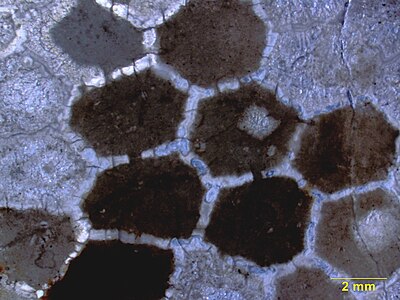Favosites
| Favosites | |
|---|---|

| |
| Favosites sp. from the Upper Ordovician of southern Indiana | |
| Scientific classification | |
| Kingdom: | Animalia |
| Phylum: | Cnidaria |
| Class: | Anthozoa |
| Family: | † |
| Genus: | †Favosites Lamarck 1816 |
| Type species | |
| F. gothlandicus | |
| Species | |
|
See text | |
| ||
| ||
| ||
| ||
| ||
| More polished Favosites fossil. |
Favosites is an extinct genus of tabulate coral characterized by polygonal closely packed corallites (giving it the common name "honeycomb coral").[1] The walls between corallites are pierced by pores known as mural pores which allowed transfer of nutrients between polyps. Favosites, like many corals, thrived in warm sunlit seas, feeding by filtering microscopic plankton with their stinging tentacles and often forming part of reef complexes.[2] The genus had a worldwide distribution from the Late Ordovician to Late Permian.[3]
Distribution[]
Favosites had a vast distribution, and its fossils can be found on every continent (except Antarctica).[3]
Species[]
The following species of Favosites have been described:[3]
- F. abnormis
- F. adaverensis
- F. afghanicus
- F. antiquus
- F. bowerbanki
- F. burkhanensis
- F. desolatus
- F. exilis
- F. fallax
- F. favosiformis
- F. favosus
- F. fusiforme
- F. goldfussi
- F. gothlandicus
- F. hisingeri
- F. ingens
- F. intricatus
- F. issensis
- F. jaaniensis
- F. kalevi
- F. lichenarioides
- F. mirandus
- F. multicarinatus
- F. oculiporoides
- F. permica
- F. petropolitana
- F. praemaximus
- F. privatus
- F. serratus
- F. subfavosus
- F. subforbesi
Gallery[]

Sagittal cross-section of Favosites, showing communication pores between the corallites.
Upper Ordovician of southern Indiana
References[]
- ^ Boardman, R.S. (1987). Fossil Invertebrates. Blackwell. p. 714.
- ^ Feldman, R.M.; Hackathorn (1996). Fossils of Ohio. Ohio Division of Geological Survey Bulletin 70. p. 577.
- ^ Jump up to: a b c Favosites at Fossilworks.org
- Tabulata
- Prehistoric Anthozoa genera
- Silurian animals of North America
- Permian animals of North America
- Carboniferous animals of North America
- Devonian animals of North America
- Ordovician animals of North America
- Silurian animals of Asia
- Permian animals of Asia
- Devonian animals of Asia
- Ordovician animals of Asia
- Devonian animals of Africa
- Devonian animals of Australia
- Permian animals of Australia
- Silurian animals of Australia
- Devonian animals of South America
- Silurian animals of South America
- Silurian animals of Europe
- Carboniferous animals of Europe
- Devonian animals of Europe
- Ordovician animals of Europe
- Fossils of Georgia (U.S. state)
- Fossils of Afghanistan
- Silurian Argentina
- Fossils of Argentina
- Fossils of Australia
- Fossils of Austria
- Fossils of Belarus
- Fossils of Belgium
- Fossils of Canada
- Fossils of China
- Devonian Colombia
- Fossils of Colombia
- Fossils of the Czech Republic
- Fossils of Estonia
- Fossils of France
- Fossils of Germany
- Fossils of Greenland
- Fossils of India
- Fossils of Indonesia
- Fossils of Iran
- Fossils of Italy
- Fossils of Japan
- Fossils of Kazakhstan
- Fossils of Kyrgyzstan
- Fossils of Laos
- Fossils of Lithuania
- Fossils of Malaysia
- Fossils of Mongolia
- Fossils of Morocco
- Fossils of New Zealand
- Fossils of Norway
- Fossils of Pakistan
- Silurian Paraguay
- Fossils of Paraguay
- Fossils of Russia
- Fossils of Saudi Arabia
- Fossils of South Africa
- Fossils of Spain
- Fossils of Sweden
- Fossils of Tajikistan
- Fossils of Thailand
- Fossils of Ukraine
- Fossils of the United Kingdom
- Fossils of the United States
- Fossils of Uzbekistan
- Fossils of Venezuela
- Fossils of Vietnam
- Floresta Formation
- Late Ordovician first appearances
- Permian genus extinctions
- Jeffersonville Limestone
- Paleontology in New Jersey
- Paleozoic life of Ontario
- Paleozoic life of British Columbia
- Paleozoic life of Manitoba
- Paleozoic life of New Brunswick
- Paleozoic life of the Northwest Territories
- Paleozoic life of Nunavut
- Paleozoic life of Quebec
- Paleozoic life of Yukon
- Fossil taxa described in 1816
- Anthozoan stubs
- Prehistoric cnidarian stubs


